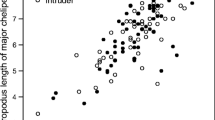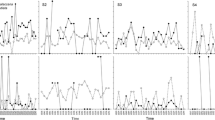Abstract
Relative body size (carapace width) and weapon size (chela length) were used as indicators of resource holding potential (RHP) in the agonistic behaviour of male shore crabs, Carcinus maenas (L.). Weapon size was found to be a more reliable predictor of the outcome of pairwise fights than body size. Crabs with longer chelae than their opponents were more likely to win fights than crabs with relatively larger bodies. Body size had less influence on the outcome of fights. Relative body and weapon size did not influence initiation of contests but did affect the likelihood of winning; however, this was significant only for weapon size. Winning crabs had heavier claws with greater surface area than losing crabs. There was no relationship between relative size and fight duration. The frequency of cheliped display increased with chela length and win- ners performed significantly more displays than losers.
Similar content being viewed by others
Author information
Authors and Affiliations
Additional information
Received: 5 February 1997 / Accepted after revision: 20 May 1997
Rights and permissions
About this article
Cite this article
Sneddon, L., Huntingford, F. & Taylor, A. Weapon size versus body size as a predictor of winning in fights between shore crabs, Carcinus maenas (L.). Behav Ecol Sociobiol 41, 237–242 (1997). https://doi.org/10.1007/s002650050384
Issue Date:
DOI: https://doi.org/10.1007/s002650050384




